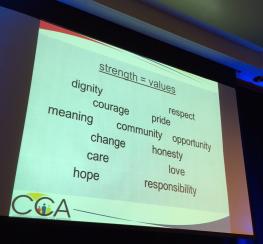
#CBAAconf: "Don't be a brand, be a movement" - David Crosbie
David Crosbie doesn't mince words, kicking off his plenary session with this: "What I’m going to do is challenge you a bit about what is happening in the charities and NFP sector."
As CEO of the Community Council of Australia, and umbrella organisation for charities, he is well placed to do so.
"The way the government approaches our sector is changing, and so are their expectations. The reality is that governments are seeking to gain greater returns from their investment in the charity and not-for-profit sector," Crosbie explained.
This trend encompasses:
- An increasing demand for services, while government income is generally stalling
- Treating service provision as a market
- Looking for greater collaboration to develop solutions - want to fund bigger organisations, rather than a whole bunch of little ones.
- More control of message (for profit contracts)
- Scaling success and return on investment approaches increasing.
- There is an increased focs on community (which is good for us), but governments are less willing to support it financially.
Key to Crosbie's context is that not-for-profits and charities have experienced a significant boom period - the numbers don't lie - 1.1 million employees, a contribution of 5% to the country's GDP and outperforming big industries such as mining and agriculture. We've been on the escalator, but this is coming to and end... the escalator is stopping...
So, how are we to look at the now and into the future to plan for our organisations? It's all about what sets us apart. "We need to think about what our strengths are. How will we position ourselves? How will we do things?"
This part of Crosbie's address was focused on our the importance of VALUES.
This played into several key points:
- While Crosbie identified some key ways that the sector is moving towards reflecting for-profit industries, he made the distinction clear: while both models can provide a service, not-for-profits also advocate for the people they serve.
- Crosbie referenced the increased competition between not-for-profits, saying that this is a dangerously short term approach coming into a period of relatively slow growth (when even the biggest companies in the country have no growth scenarios in their future planning).
- He also warned against becoming a 'stand and deliver' service provider, rather than a focus on solving a problem and serving a community. "I see far too many charities doing just stand and deliver, and some how expecting they’ll get more money year on year – you won’t, I won’t".
The questions we need to be asking are: What are we trying to achieve and why? And how can we do it better?
When thinking about answering these questions, Crosbie recommends putting aside where you now, and what happens at the moment. Go back to the start - think about how we might better serve our community.
What are the values that matter to us? How do we enact them? How do we communicate them to others? How do other people know that what we do is valuable?
In answering these questions, and tapping into the important ideas behind our services, we can move from being a brand, to being a movement.
A classic example of this in action is the 1997 Apple advertisement ("The ones who are crazy enough to think they can change the world, do.")
"We as a sector haven’t had to think about this too much, but now we need to start doing the work."
With a presentation full of great anecdotes, Crosbie said he shared more of his failures than successes - as that's where he learnt the most. In his experience as a teacher, he learnt how important it is that others value your work - service users (students), the wider community (other teachers and parents) and beyond. He learnt to document his services and impact, to validate not just himself, but all of those involved.
Crosbie was adamant on this point -
DO IT! Learn to document and create value - "if you don't, you're vulnerable".
The full recording of David's presentation "Moving forward by holding on to what you value" is available to listen to below:
Facebook comments